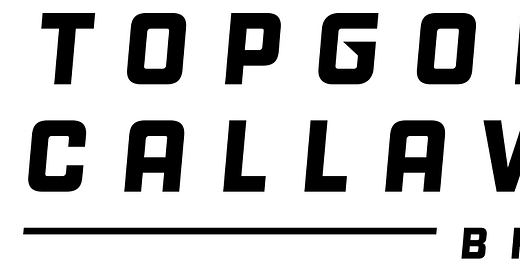Despite Recent Five-Year Lows, the Future Is Bright for Callaway
That's what one set of analysts with their ear to the ground say, anyway.
Most stock pickers experience as many ups as downs, but Callaway — or Topgolf Callaway Brands Corporation to give it its NYSE-traded title (ticker “MODG”) — is not far above the worst of them over the past 12 months.
While the S&P 500 climbed approximately 25% in 2024, Callaway fell almost a third in value over the calendar year — and more than 50% from its summer highs.
Morning Star published its best and worst stocks of 2024 recently, and while Callaway was thankfully absent, its performance in 2024 was not a whole lot better than the dredges of the market, with Walgreens, Intel and Covid-19 darlings Moderna all falling around 60% over the past 12 months.
Indeed, Callaway’s 52-week low of $7.22 per share, set in December, took it below its March 2020 low of $7.27 — and that was at the beginning of the pandemic, when generalized lockdowns put golf out of reach, if not out of mind, for everyone, at least until common sense prevailed.
Among the reasons for its bleak performance over 2024 were stalling revenue and falling profits and an especially poor financial performance from the Topgolf arm that has become such a significant element in the overall group performance.
Callaway acquired Topgolf in a $2 billion deal in 2021, a move which led to the creation of that single NYSE-traded entity. Despite massive capital investment and expansion since then, the group’s senior management team decided in September to separate out the two companies and allow each to stand on its own two feet.
The most recent Q3 2024 stock exchange filings saw Topgolf’s same venue sales decline 11% and overall income increase just 1.2% year-on-year — a figure that was stark given that several new venue openings in the year took the company past the 100-venue mark globally. (A press release celebrating the opening of Mississippi’s first Topgolf venue last month declared it to be the 108th Topgolf around the world.)
In a statement last September, the Topgolf Callaway Brands president and CEO Chip Brewer said (emphasis mine):
“Over the last decade plus, we have transformed Callaway into the No. 1 brand in golf equipment, while building a successful and complementary apparel and accessory business. We believe this business, on a stand-alone basis, will be well understood and valued by the market. Since our merger with Topgolf, we have made considerable investments in the Topgolf business that have dramatically expanded its scale, digital capabilities and venue profitability. These investments, combined with the hard work of the Topgolf team, have allowed us to outperform our original growth and free cashflow expectations. Looking forward, we remain convinced that Topgolf is a high-quality, free cash flow generating business with a significant future value-creation opportunity.
“Topgolf is transforming the game of golf and is expected to deliver substantial financial returns over time. At the same time, Topgolf has a different operating model, capital structure and investment thesis than Callaway, and as a result, the Board has determined that separating Topgolf will best position Topgolf and Callaway for success and maximize shareholder value.”
A few months on from that news — a few months that brought the Topgolf Callaway Brands company to that five-year stock low — the outlook is now bright, at least according to one set of market analysts who have been following things closely.
David Katz and Randal Konik, analysts with Jefferies, the New York-headquartered investment bank and financial services company, this week upgraded Callaway from “hold” to “buy” and gave the stock a $13 price target.
In his analysis of the stock, deploying proprietary sum-of-the-parts techniques that compare Callaway favorably against its biggest competitor, Acushnet (the firm behind the Titleist and FootJoy brands), Konik wrote,
“While TG [Topgolf] fundamentals are weak, and MODG has suffered misexecution, shares appear oversold. With a separation ahead, and [a SOTP or Sum-of-the-Parts analysis of] ~2x current share price, MODG offers strong value, we believe.
“Despite recent doubts, history shows a deep understanding of golf, and tailwinds in golf are robust.”
Having started the New Year at less than $8, the Callaway share price received a bump to more than $9 at the time of writing on Friday, January 3.
Whether that turns out to be just a short-term spike prompted by day trading, or the start of better things to come for the Callaway group over the longer term that matches those analyst expectations, time, of course, will tell.
But given the broader and unmistakable trend of growth in golf-as-entertainment, against the more traditional mode of golf-as-status-symbol, the management decision to untether Callaway (golf-as-status-symbol) from Topgolf (golf-as-entertainment) and allow each business to pursue its own investment strategies independent of one another would appear, from this vantage point, to make perfect sense.
Stock-picking golf-lovers and stock-loving golf-hackers alike will be watching this space closely.





